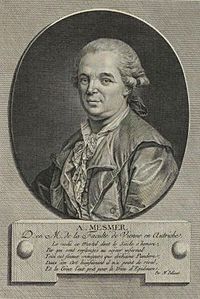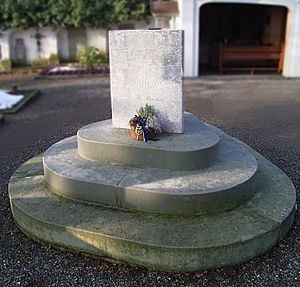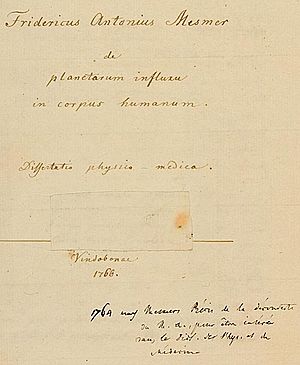Franz Mesmer facts for kids
Quick facts for kids
Franz Mesmer
|
|
|---|---|

Print of Franz Anton Mesmer
(Musée de la Révolution française) |
|
| Born |
Franz Anton Mesmer
23 May 1734 Iznang, Bishopric of Constance
|
| Died | 5 March 1815 (aged 80) Meersburg, Baden
|
| Alma mater | University of Vienna |
| Known for | Animal magnetism |
Franz Anton Mesmer (born May 23, 1734 – died March 5, 1815) was a German doctor. He was very interested in astronomy. Mesmer believed that a special kind of energy moved between all living and non-living things. He called this "animal magnetism". Later, people often called this idea "mesmerism".
Mesmer's ideas became very popular between about 1780 and 1850. They even influenced people until the late 1800s. In 1843, a Scottish doctor named James Braid used Mesmer's ideas to create a new technique. He called it "hypnotism". Today, "mesmerism" usually means the same thing as "hypnosis". Mesmer also loved the arts, especially music. He was friends with famous composers like Haydn and Mozart.
Contents
Mesmer's Early Life and Studies
Franz Anton Mesmer was born in a small village called Iznang. This village is near Lake Constance in Germany. His father was a master forester.
Mesmer first studied at Jesuit universities. Then, in 1759, he began studying medicine at the University of Vienna. In 1766, he wrote his final paper for his medical degree. It was about how the moon and other planets might affect the human body and illnesses. He thought that the movements of the sun and moon could create "tides" inside people's bodies.
In 1768, Mesmer married a rich widow named Anna Maria von Posch. He then started his own medical practice in Vienna. During the summers, he lived on a beautiful estate. He used his wealth to support artists and musicians. He even helped the young Wolfgang Amadeus Mozart by arranging a performance of one of his operas. Mozart later made a funny reference to Mesmer in his own opera, Così fan tutte.
What Was Animal Magnetism?
In 1774, Mesmer tried a new treatment on a patient named Francisca Österlin. She had a condition called hysteria. Mesmer gave her a special drink with iron. Then, he put magnets on different parts of her body. She said she felt strange fluids moving through her body. Her symptoms got better for a few hours.
Mesmer believed the magnets didn't cure her by themselves. He thought he had given her his own "animal magnetism." Soon, he stopped using magnets in his treatments. He felt he could transfer this special energy just by using his hands.
In 1775, Mesmer was asked to share his ideas with the Munich Academy of Sciences. They wanted his opinion on the exorcisms performed by a priest and healer named Johann Joseph Gassner. Mesmer said that Gassner was sincere. But he believed Gassner's cures happened because he had a lot of animal magnetism. This event showed how Mesmer's scientific ideas were different from religious beliefs about healing.
Mesmer had a difficult case with an 18-year-old musician, Maria Theresia Paradis. She was blind, and Mesmer only partly helped her. This caused a scandal, and Mesmer left Vienna in 1777.
In February 1778, Mesmer moved to Paris. He opened a medical practice there and became very popular. People in Paris had strong opinions about him. Some thought he was a fake, while others believed he had made a huge discovery.
Mesmer tried to get his ideas officially approved by the French Academy of Sciences. But he was not successful. In 1779, he wrote a book called Mémoire sur la découverte du magnétisme animal. In it, he explained his theory in 27 main points. Some experts today compare Mesmer's animal magnetism to the Qi (chi) energy in Traditional Chinese Medicine.
Mesmer believed that good health meant life energy flowed freely through thousands of channels in our bodies. Illness happened when something blocked this flow. To get healthy again, these blocks needed to be removed. This would cause a "crisis" in the body, which would then restore health. Mesmer aimed to help this natural process. For example, to help someone with mental illness, he might try to cause a fit of madness. He thought magnetism could speed up these crises safely.
How Mesmer Treated Patients
Mesmer treated people both one-on-one and in groups. When treating someone alone, he would sit facing them. Their knees would touch, and he would hold their thumbs. He would stare into their eyes. Then, he would make "passes" with his hands. He moved his hands from the patient's shoulders down their arms. He would also press his fingers on their stomach area, sometimes for hours. Many patients felt strange things or had shaking fits. These were seen as "crises" that would lead to a cure. Mesmer often ended his treatments by playing music on a glass harmonica.
By 1780, Mesmer had too many patients to treat individually. So, he created a group treatment called the "baquet." This was a large wooden tub filled with water and iron filings. Patients would sit around it, holding iron rods that came out of the tub. They believed the tub was filled with magnetic fluid.
Official Investigation

In 1784, King Louis XVI decided to investigate animal magnetism. He appointed a group of important scientists and doctors to study it. This group included famous people like the chemist Antoine Lavoisier and the American ambassador Benjamin Franklin.
The commission did experiments to see if Mesmer's "fluid" really existed. They found no proof of such a fluid. They concluded that any good effects from the treatment were due to the patient's "imagination." One member of the commission, Antoine Laurent de Jussieu, disagreed. He thought Mesmer's ideas were worth more study.
The commission did not examine Mesmer himself. Instead, they studied the practices of his student, Charles d'Eslon. They used "blind trials" in their study. This meant some patients didn't know if they were being treated or not. The commission learned that mesmerism only seemed to work if the patient knew they were being treated. They called this "Imagination." But today, their findings are seen as the first time the placebo effect was observed. This is when a patient feels better just because they believe a treatment will work, even if it's not a real medicine.
After these investigations, Mesmer was forced to leave Paris. He continued to practice in Switzerland for some years. He died in 1815 in Meersburg, Germany.
A monk named Abbé Faria, who lived in Paris at the same time as Mesmer, had a different idea. He said that "nothing comes from the magnetizer; everything comes from the subject." This means he believed the patient's own mind and belief (or autosuggestion) were what caused the changes, not any special energy from the healer.
Mesmer's Writings
- On the Influence of the Planets on the Human Body (1766)
- Memoir on the Discovery of Animal Magnetism (1779)
- Theory of the World and Organized Beings (1784)
- Mesmerism or the System of Interactions (1814)
Mesmer in Movies
- In the 1949 movie Black Magic, Charles Goldner played Mesmer.
- In the 1994 movie Mesmer, Alan Rickman played Mesmer.
See also
 In Spanish: Franz Anton Mesmer para niños
In Spanish: Franz Anton Mesmer para niños
- Animal magnetism
- Royal Commission on Animal Magnetism


